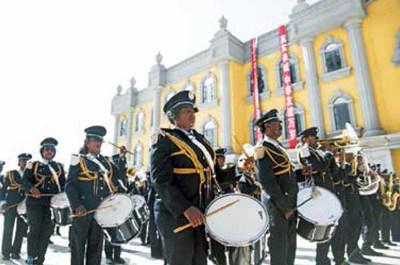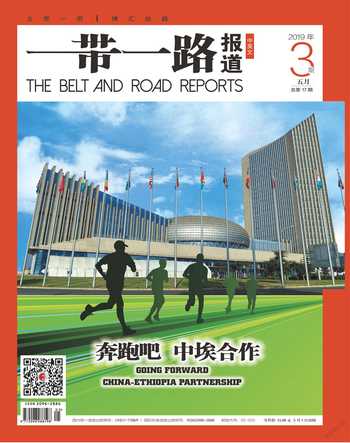争当下—个全球制造业中心
2019-09-10赵磊
赵磊

To be the next global manufacturing center
——Research report on Ethiopia
埃塞俄比亚是具有3000多年文明史的古国,国土面积114万平方公里,人口过亿,是非洲第二人口大国。
2010年,埃塞政府启动首个“增长与转型”计划(Growth and TransformationPlan I)。多年来,埃塞政府各级官员高频次到中国考察,回国后积极发展基础设施、能源和电信等基础性行业,建设以出口创汇为先导的工业园,为国民经济的长期发展打下基础。2013年,埃塞政府聘请中国开发区协会为其拟订工业园发展规划。2014年埃塞政府成立工业园开发公司(IPDC),并于2015年颁布《工业园法》,将工业化作为重点优先发展方向,工业园开发战略成为其中的核心战略举措。
另一方面,埃塞政府积极倡导以农产品加工为核心的农业现代化,夯实农业和畜牧业基础,大力发展咖啡、油料种子、鲜花、牛羊以及皮革出口等传统优势产业。2015年以来,埃塞俄比亚GDP年均增长维持在10%以上。
就产能合作而言,当劳动力密集型产业在中国和东南亚面临成本上升时,埃塞希望利用本国劳动力优势承接国际产能转移,复制中国式的工业化路径,实现从农业主导向轻工制造业主导的经济升级,进而使埃塞成为下一个全球制造业中心。
(一)亚吉铁路
亚吉铁路采用中国标准、中国设计、中国资金、中国监理和中国装备建设而成,全长751.7公里,客运设计时速120公里,货运设计时速80公里,总投资约38亿美元。这是中国在非洲建设的第一條集技术、标准、设备、融资、施工、监理、运营和管理为一体的全流程“中国元素”的电气化铁路。
2018年1月1日,亚吉铁路商业运营开通仪式在亚的斯亚贝巴拉布火车站举行。在对拉布火车站的调研中了解到,目前,早晨8点发出一列客车,第二天从终点车站回程一列(两天往返一次);货车是一天一对。现今,亚吉铁路已经建成19个车站,开通5站,远期将达到45个车站。亚吉铁路2018年4月货物运输收入共235万多美元,客运量达到1.2万人,收入达15万美元(票价,当地人最远需花费1008比尔,外国人需花费2016比尔)。
在考察中发现,诸如电力不稳定、法律法规不健全、沿线安全等问题也时有存在。因此,项目完成后的配套、培训等还将长期进行。
(二)亚的斯亚贝巴轻轨
亚的斯亚贝巴轻轨是东非第一条现代化的城市轻轨,轻轨目前有南北线、东西线两条线路,全长共31.05公里,设有39个车站。亚的斯亚贝巴轻轨由中国中铁二局承建,使用全套中国标准、中国设计和中国设备。
轻轨票价分为2、4、6比尔不等,运营时间从早6点到晚10点。高峰期15分钟一列,平时间隔20分钟一列。自2015年下半年通车至2018年5月31日,轻轨已安全运营985天,累计开行列车23万列次,运营里程达584.2万公里,共计运送旅客1.29亿人次,日均客流10.45万人次,历史最高单日客流侣.5万人次(在国内,部分城市的地铁日均客流也就2万人)。轻轨一节车厢最大载客317人,地铁载客1600人。所以,首都轻轨日均10万人,极其不易。
轻轨从多方面改变了这座城市的面貌。以前由于缺乏公共交通,到了晚上8点,整座城市就进入了睡眠状态。现在轻轨运营到晚上10点,商店、餐馆可以开得晚一些,城市的商业因此活跃起来。轻轨成为埃塞的城市品牌,每年有很多非洲大型会议在亚的斯亚贝巴召开,很多国家代表团都会来参观这条轻轨,并对它赞不绝口。
(三)产业园
目前,埃塞政府主导建设的8座在建工业园全部由中资企业承建,已建成的2座非政府主导工业园——东方工业园和华坚国际轻工业城全系中国民营企业投资开发。
东方工业园(Eastern Industry Zone)是中国民营企业投资的产业园,也是该国境内首个由外资建成且正式运营的工业园区,推动了埃塞工业园法的落地。2008年,中国江苏永元投资有限公司在埃塞投资建设东方工业园,将现代工业园发展理念和模式引入埃塞。东方工业园一期工程总投入约2亿美元,2013年中国提出“一带一路”倡议后,一大批企业到非洲寻求发展,进入东方工业园的企业迅速多起来。目前,工业园一期已有83家入园企业,解决了1.4万当地人员就业。
华坚国际轻工业城:华坚鞋厂是最早落户东方工业园的企业之一,并被视作中国与埃塞进行产能合作的样板。截至2017年底,华坚成为中国在埃塞最大规模的民营企业,已累计出口创汇超过1.22亿美元,为当地解决了7500多人的就业问题。该企业年产超过500万双女鞋,是埃塞最大的鞋业出口企业,占埃塞鞋业出口的65%以上。
作为劳动密集型企业,华坚也受益于埃塞低廉的劳动力成本,巩固了企业的国际竞争力。这里的人工成本是中国的七分之一,电费是中国的一半。尽管物流成本高,但综合算下来,效益还是中国国内的若干倍。目前,亚吉铁路已经实现商业化运营,但货物出口流程不畅,华坚等企业依然依赖公路运输,物流成本和时间成本较高。
通过进入非洲开始谋划全球布局,华坚集团国内的两个生产基地仍在生产,高端产品在东莞完成,中低端产品在赣州完成,而未来准备把60%的产能转移到埃塞等非洲国家。非洲以及东南亚国家的产品出口享受免关税、免配额等政策,中国企业在埃塞生产的鞋和服装等产品出口到欧美,可以享受零关税政策。
英国专业咨询机构Ernst&Young连续五年推出的非洲国家投资吸引力指数(AAI)报告指出,埃塞俄比亚已取代尼日利亚成为非洲最具吸引力的投资目的国。但考察中也发现存在不少问题。
(一)税收方面。在制定具体政策方面,经常出现政策制定者不了解行业实际情况,对产业链条认知不足等问题。另外,埃塞对产品税收政策制定比较宽泛,通则过多、细则过少,在具体政策执行过程中,税务和海关等官员存在执法自由裁量权较大、税收执法过当等问题。
(二)货币方面存在贬值风险。受国际大宗商品价格低迷影响,埃塞的咖啡等农产品出口创汇疲软。英国《金融时报》的数据显示,埃塞目前的外汇储备为30.83亿美元,而外债则累计231.67亿美元。攀升的贸易赤字影响着埃塞的偿付能力。
经过调研,企业到埃塞发展需从以下几方面着手:
第一,园区建设不是越多越好。海外产业园区的建设需要对产能合作与产业园区发展做更系统的剖析。
第二,加强电力等基建方面的合作。埃塞俄比亚拥有丰富的水能,但开发利用率不足5%。再加上老旧的输配电系统,导致电力不稳定问题突出。目前,埃塞正在努力解决停电问题,升级电网和进行电网改造。
第三,加强跨文化管理。“一带一路”建设强调文明互鉴,还要在构建“人文格局”上下功夫。
第四,更多关注教育、医疗等民生问题。要鼓励更多的企业与人才扎根非洲,需要配套教育和医疗支持。无论是国有企业还是民营企业在海外,都希望以政府的力量兴建海外的华人医院与学校,这对人才扎根非洲是有助益的。
第五,建议在非洲不同区域(如东非的埃塞、西非的尼日利亚等)建“一带一路”能力中心。目前,很多中资企业将当地员工派到中国培训,不仅成本高,且回国后培育人员离开企业的比例较大。能力中心建设有助于解决非洲从官员到员工对“一带一路”关键性问题的近距离认知。

I Overview of Ethiopian Economy
Ethiopia is an ancient country with a civilization history of 3,000 years. Witha land area of l.14 million square kilometers and a population of over 100 million,it is the second most populous country in Africa.
In 2010, the Ethiopian government launched Growth and Transformation PlanI. Over the years, officials from the Ethiopian government at all levels have madefrequent visits to China. Afier returning to Ethiopia, they have actively advancedinfrastructure development, energy telecommunications and other basic industries,and built industrial parks spearheaded by earning foreign exchange through export,laying a foundation for the long-term development of the national economy.In 2013, the Ethiopian government invited China Association of DevelopmentZones (CADZ) to draw up the A Proclamation on Industrial Parks. The Ethiopiangovernment established the Industrial Park Development Corporation (IPDC) in2014 and promulgated the Industrial Park Proclamation in 2015. Industrializationwas set as the priority in development, and the industrial park development strategybecame a core strategic measure.
On the other hand, the Ethiopian government actively advocates agriculturalmodernization centered on the agricultural product processing, consolidates thefoundation of agriculture and animal husbandry and vigorously develops traditionaladvantageous industries such as coffee, oil seeds, flowers, cattle and sheep, andleather export. Since 2015, Ethiopia's GDP has maintained an annual growth rate ofover 10%.
In terms of capacity cooperation, when labor-intensive industries are facingrising costs in China and Southeast Asia, Ethiopia hopes to take advantage ofits strength in labor, undertake international capacity transfer and replicate theChinese-style industrialization path. It aims to transform an agrarian economyinto one donunated by light manufacturing, making Ethiopia the next globalmanufacturing center.
II Progress of the Belt and Road Initiative Construction in Ethiopia
Addis Ababa-Djibouti Railway is built with Chinese standards, design, funds,supervision and equipment. The railway is 751.7 kilometers long, with a designedspeed of 120 km/h for passenger and 80 km/h for freight. The total investment isabout USD 3.8 billion. It is China's first electrified railway in Africa with Chineseelements fully integrated, including technology standards, equipment, financing,construction, supervision, operation and management.

The opening ceremony of the commercial operation of Addis Ababa-DjiboutiRailway was held at the Lebu Railway Station, Addis Ababa on January l, 2018.According to the investigation of Lebu Railway Station, a passenger train leavesat 8 a.m. and returns the next day from the terminal station (once every two days).A pair of freight trains run each day. Now, 19 stations have been built along AddisAbaba-Djibouti Railway, including 5 0pened. The number of stations is expectedto reach 45 in the future. In April 2018, the railway eamed more than USD 2.35million in freight revenue and USD 150,000 byserving 12,000 passengers (fare: as much as ETB1,008 for locals and ETB 2,016 for foreigners).
During the investigation, problems such aspower instability, imperfect laws and regulations, aswell as safety risks are also found from time to time.Therefore, facilities improvement and personneltraining will continue after project completion for along term.
(II) Addis Ababa Light Rail
Addis Ababa Light Rail is the first modem urbanlight rail in East Africa. It currently comprises twolines, the north-south line and the east-west line, witha total length of 31.05 kilometers and 39 stations.Addis Ababa Light Rail was built by China RailwayErju Construction Co.,Ltd, adopting a full range ofChinese standards, Chinese designs and Cluneseequipment.
The fares include ETB 2, ETB 4 and ETB 6.Operating hours are from 6 a.m. t0 10 p.m. The trainruns every 15 minutes in peak time and every 20minutes in normal time. Since the second half of 2015t0 2018 0n May 31, the light rail had operated safelyfor 985 days, with 230,000 trains running and a totalnuleage of 5.842 million kilometers. It had served atotal of 129 nullion passengers, with a daily averageof 104,500 and a record of 185,000 (In China, theaverage daily passenger flow on the subway in somecities is only 20,000 people). A light rail camagecan accommodate a maximum of 317 passengers,while the subway can hold l,600 people. Therefore,an average of 100,000 passengers a day is indeedimpressive.
The light rail has changed the look of the cityin many ways. Previously, due to the lack of publictransportation, the city went to sleep at 8 p.m.Now, the light rail runs until 10 p.m., so shops andrestaurants can stay open later, and business in the citybrisks up. The light rail has become an urban brand ofEthiopia. Every year, major African conferences areheld in Addis Ababa, and many delegations come tovisit the light rail, showing their appreciation.
(III) Industrial Park
At present, all the 8 industrial parks underconstruction led by the Ethiopian government areundertaken by Clunese-funded enterprises. EasternIndustry Zone and Huajian International LightIndustry City(Ethiopia) PLC, the 2 completed non-government leading industrial parks, were fullyinvested and developed by Chinese private enterprises.
The Ethiopian Eastern Industry Zone, an industrialpark invested by private enterprises in China, is thefirst industrial park built and formally operated byforeign capital in the country which has promotedthe implementation of the Ethiopian IndustrialPark Proclamation. In 2008, Jiangsu YongyuanInvestment Co., Ltd. invested in the construction ofEastem Industry Zone in Ethiopia and introduced thedevelopment concept and mode of modem industrialpark into the country. The total investment of EastemIndustry Zone Phase I is about USD 200 million.After China put forward the Belt and Road Initiativein 2013, a large number of enterprises went to Africafor development. Many enterprises entered EastemIndustry Zone. So far, 83 enterprises have entered thefirst phase ofthe project and created 14,000 local jobs.
Huajian International Light Industry City:Huajian's shoe factory was one ofthe first enterprisesto enter Eastern Industry Zone. It is considered amodel for capacity cooperation between China andEthiopia. By the end of 2017, Huajian had becomeChina's largest private enterprise in Ethiopia, withover USD 122 million eamed from exports and over7,500 local jobs created. With an annual output ofover 5 million pairs ofwomen's shoes, the companyis the largest shoe exporter in Ethiopia, accounting forover 65% of Ethiopia's shoe exports.
As a labor-intensive enterprise, Huajian has alsobenefited from the low labor costs in Ethiopia andconsolidated its international competitiveness. Laborcosts here are l/7 0f that in China, and electricity billsare half that in China. Although the logistic cost ishigh, the comprehensive benefits are several timeshigher than those in China. The Addis Ababa-DjiboutiRailway has been commercialized, but the exportprocess is still to be smoothened. Huajian and otherenterprises still rely on road transportation, and thelogistics cost high in both time and money.
Entering Africa, Huajian started to plan its globallayout. Its two domestic production bases are stillin production. High-end products are produced inDongguan and lower-end products in Ganzhou.The group plans to transfer 60% of its productioncapacity to Ethiopia and other African countries inthe future. Export from African and Southeast Asiancountries enjoy tariff-free and quota-free policies.Shoes, clothing and other products made by Chinesecompanies in Ethiopia enjoy zero tariffs whenexported to Europe and the US.
III Existing Problems and Related Suggestions
Etluopia has overtaken Nigeria as Africa's most attractive destination forinvestment, according to a five-year Investment Attractiveness Index (AAI) studyby the UK-based consultancy Emst&Young. However, many problems were foundin the investigation.
(I) Taxation. When formulating specific policies, some policy makers do notunderstand the actual situation of the industry and have insufficient knowledge ofthe industrial chain. What's more, the product tax policy of Ethiopia is relativelybroad, with too many general principles and too few detailed rules. Whenimplementing specific policies, tax and customs officials have great discretion inlaw enforcement, and there are problems such as excessive tax law enforcement.
(II) There is a risk of currency devaluation. Affected by the downturn ininternational commodity prices, coffee and other Ethiopian agricultural products areweak in earning foreign exchange through export. According to the latest figuresfrom the UK Financial Times, Ethiopia's foreign exchange reserves are now USD3.083 billion, while its foreign debt accumulates to USD 23.167 billion. A risingtrade deficit threeatens Ethiopia's solvency.
After investigation, the author puts forward the following developmentsuggestions:
First of all, it may not be a good idea to build as many industrial parks aspossible. The construction of overseas industrial parks requires a more systematicanalysis of production capacity cooperation and industrial park development.
Secondly, cooperation in power and other infrastructure projects should bestrengthened. Ethiopia has plenty of water power, but less than 5% of it is exploited.The old transnussion and distribution system have led to the conspicuous problemsof power instability. Ethiopia is now working intensively to deal with blackouts andupgrading its power grid.
Thirdly, the cross-cultural management should be improved. The Belt andRoad Initiative values mutual learning among civilizations. More effort should bemade to build the people-to-people ties.
Fourthly, more attention should be paid to education, medical care and otherlivelihood issues. We should encourage more enterprises and talents to take rootsin Africa, which requires supporting education and medical care services. Bothstate-owned enterprises and private companies hope to build Chinese hospitals andschools overseas with government support. This will help talents settle inAfrica.
Fifthly, it is suggested to build Belt and Road capacity centers in differentregions of Africa, including Ethiopia in the east and Nigeria in the west. At present,many Chinese companies send their local employees in Africa to China for training.It is expensive and it is highly possible that they will leave the company upon theirreturn. The construction of capacity center will help African officials and staff getup close and personal on key issues ofthe Belt and Road Initiative.
